Author Archive
Useful Tips For Watering Your Garden
A consistent supply of water plays an integral role in the nurturing and maintenance of trees, crops, plants and flowers on a daily basis. Nevertheless when it comes to supplying a garden with water most people believe that so long as plants are watered all is well. Unfortunately this may not necessarily be true as there are many factors that affect the way trees, plants and flowers receive water. With that said here are a few insightful tips for watering gardens that gardeners can utilize in order to maximize the amount of water their plants, trees and flowers receive.
Mulching Improves Water Retention In Gardens

Even though insufficient water can be harmful to trees, plants or flowers an excessive supply of water can practically have the same effect. So it would be safe to say that not only do gardens need a consistent supply of water to stay well maintained but they need accurately, proportioned, amounts as well.
It may seem like somewhat of a challenge to actually estimate what constitutes the the correct proportion of water that should be supplied to a garden. Even though there is not really a standard way to gauge this there are some methods gardeners can apply to make sure plants always have the water they need.
Mulching is a very effective gardening method that helps gardeners to reduce the excessive watering of gardens. This method also helps to improve water retention and soil structure so that plants don’t constantly need to be watered.
Test Soil Regularly To Eliminate Unnecessary Watering Of Gardens
Disproportionately watering gardens tends to not only be a wasteful practice but it also causes gardeners to work more than necessary. Therefore gardeners should make it a practice to conduct regular tests on soil to determine whether or not plants need an immediate supply of water.
The best way to do this is to take a spade and push it deep into the soil. Once you pull the spade out check to see if it’s damp or dry which should give you an idea of if it’s time to water or not.
Remember though if you have clay soil it may feel damp whether it’s irrigated or not and sandy soil can feel dry even if it’s wet. So in cases like these gardeners should watch plants for when they start to show signs of water stress to determine when water should be supplied.
Some Mechanisms Can Provide An Adequate And Timely Water Supply To Gardens
Over time gardeners have taken advantage of the availability of certain tools that can help to effectively manage the water supply to their gardens. Some of these tools include automated irrigation and sprinkler systems which can not only minimize the time spent watering gardens but they can adequately supply water to plants at the required time.
Need Help With Irrigation Or Sprinkler Installation? Let DK Landscaping Manage The Job For You!
Are you are interested in installing an irrigation or sprinkler system in your garden but don’t know what to? Well not to worry here at DK Landscaping Inc. we specialize in all your landscaping and gardening services and we’d be happy to come in and complete the installation for you.
Striving to provide the highest, quality, services to all clients we offer extremely affordable rates and we work with clients to manage any type of gardening environment. So give us a call at: 707 280-3632 or visit our website:dklandscaping.com for more information.
Useful Gardening Tips That Promote Healthy Landscapes
As a gardener or landscaper maintaining beautiful surroundings and healthy plants is certainly an important priority and even though this may sometimes be challenging it is necessary if landscapes are to remain healthy and attractive. You want your friends and family to have fun in a garden that is full of life and energy and good maintenance is the key. There are several useful tips that gardeners can apply in effort to promote healthy landscapes and gardens.
Excellent Soil Quality is Vital in Maintaining Healthy Landscapes

Good soil quality is extremely important if plants and trees are to grow healthy and to their full potential. If you discover that your plants, trees or flowers are not thriving this may be due to poor soil quality however one approach that has proven to improve and maintain the quality of soil is the use of fertilizer.
Fertilizer can come in several forms and is an excellent way to enrich soil and promote plant growth. One of the most common forms of fertilizer used throughout gardens and landscapes is organic fertilizer.
Essentially organic fertilizer consist of naturally bio-degradable materials mainly in the form of animal manure but can also be other natural ingredients. It is great for gardens and crops as it not only restores soil quality but improves the long term health of soil promoting healthy landscapes overall..
Mulching Promotes Healthy Landscapes and Gardens
In looking for great ways to promote healthy landscapes and gardens another very useful tip gardeners can utilize is the application of mulch to garden beds and other landscape areas. Generally mulch is used to eliminate weeds, protect and stabilize plants and trees as well as to help soil retain moisture.
Mainly consisting of several, different, materials including chopped leaves, straw, grass clippings, wood chips,sawdust, shredded bark, gravel or stone mulch can be used in vegetable gardens, flower beds, plant pots, around trees, walkway areas, hedges and more.
Among many common gardening techniques the use of mulch has been found to be an easy, environmentally friendly way to promote healthy landscapes and gardens.
Proficient Irrigation Systems Help Promote Healthy Landscapes
In order for gardens or landscapes to remain lush and healthy having an adequate water supply is very important. So a great way to ensure that plants are properly supplied with water is by installing an irrigation system that provides a precise and timely supply of water to landscapes and gardens.
An irrigation system basically obtains water from a source and distributes it equally and uniformly to specific areas throughout gardens. Different kinds of irrigation used include high or micro flow irrigation, in-ground irrigation and automatic irrigation systems.
Over time irrigation methods have improved to better manage different types of gardening done so depending on what type of gardening you do installing the appropriate irrigation system is the best way to ensure gardens and landscapes receive the water they require.
Need Help With Your Landscaping?
Here at Dk Landscaping Inc. we aim to provide the highest quality landscaping and gardening services to clients. Our dedicated team works with clients to manage any type of gardening or landscape services you may need. Whether it be mulching, pruning, irrigation or even planting with affordable rates and great service we’d be happy to come in and assist. Contact us for more information.
Improving the Landscape of Narrow Walkways
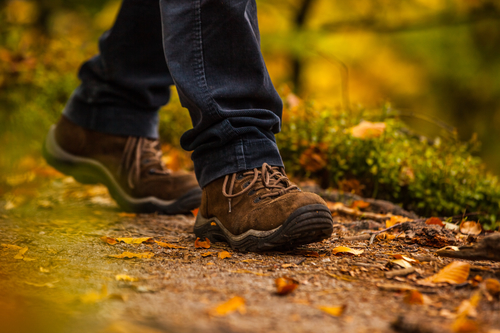 Are you a garden enthusiast who is always looking for ways to enhance your surroundings? Well if you are they’re quite a few simple things you can do to uplift and make a few improvements. Let’s take for instance landscapes that have narrow walkways within their perimeter.
Are you a garden enthusiast who is always looking for ways to enhance your surroundings? Well if you are they’re quite a few simple things you can do to uplift and make a few improvements. Let’s take for instance landscapes that have narrow walkways within their perimeter.
Gardens or outdoor landscapes are set up in such a way that there are certain areas designated for the location of plants, trees and blooms as well as other areas that facilitate the movement of traffic throughout the surroundings known as paths or walkways.
Narrow Walkways can Pose Certain Issues in Landscapes
The main purpose of having walkways throughout gardens is to provide a specified area for persons to travel without causing damage to lawns or blooms. Nevertheless over time some people have used walkways to decorate or add additional character to their outdoor surroundings.
In most landscapes the size of trees or the number of plants increase after a while which can eventually result in smaller more narrow walkways. This can decrease walking space in gardens which can eventually lead to the damage of trees, lawns, plants or flowers.
Over time walkways could incur certain damage causing them get narrow. Some can be a result of the outdoor elements mainly rain or snow or others could be a result of physical or structural damage. Nevertheless regardless of how damaged is sustained its obvious that repair will be necessary to restore walkways to what they should be.
Perhaps a bit of mortar could be used to reconstruct damaged areas or you may have to redesign the entire walkway depending on the extent of the damage but be sure to cover garden beds with tarpaulin to protect the plants you intend to keep.
Increased plant growth is also a very common circumstance that can cause narrow walkways to develop. As we are all aware plants compete for space and grow continually in ideal conditions which can sometimes present certain issues if they’re not properly maintained.
In cases like this plant overgrowth tends to invade areas designated for walking resulting in narrow walkways. Projecting tree branches, overgrown lawns, weeds etc. can all affect the space available to walk so by utilizing pruning and other maintenance techniques gardeners can control plant growth in gardens to maintain adequate space and eliminate narrow walkways.
Plants That Boost Appearance
For people residing in urban areas the best plants to use are low-growing perennials. Besides their beautiful shades most of them die in the winter or can be cut to the ground. Making it easy for gardeners during winter and the upcoming growing season.
The Lysimachia nummularia species possesses a delicate looking foliage that covers ground quickly and softens the edges of a path and using slightly taller plants in landscapes would also prove sensible as they won’t bend into the path creating narrow walkways. In addition to this they will add a contrasting feature to the surroundings.
Need Help With A Narrow Walkway? DK Landscaping Inc. Us Here To Help!
Here at DK Landscaping Inc. we specialize in all your landscaping needs and aim to provide the highest quality services to clients at an affordable price. If you may need assistance repairing, restoring or improving a narrow walkway we’d be happy to come in and give you a hand. Give us a call at 707 217-6508 or contact us via our website.
Effective Gardening Tips Part 2 – Which Type of Irrigation is Best
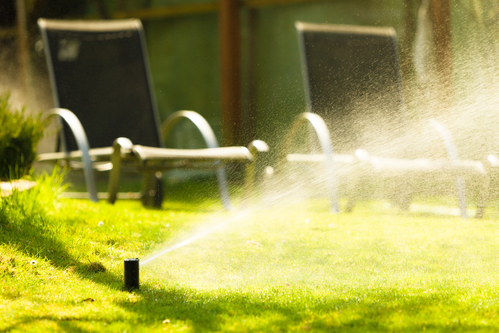 If you are a gardener, farmer or even a landscaper you understand the necessity of supplying your plants, gardens or crops with adequate water. Normally most gardeners use hoses or watering cans to water gardens but this is not always as effective because sometimes enough water might not penetrate the soil. In addition it might not be sufficient to supply what plants really require. An effective way to tackle issues such as this is to install an irrigation system which will properly supply gardens or crops with an adequate and timely supply of water.
If you are a gardener, farmer or even a landscaper you understand the necessity of supplying your plants, gardens or crops with adequate water. Normally most gardeners use hoses or watering cans to water gardens but this is not always as effective because sometimes enough water might not penetrate the soil. In addition it might not be sufficient to supply what plants really require. An effective way to tackle issues such as this is to install an irrigation system which will properly supply gardens or crops with an adequate and timely supply of water.
Different Types
The basic concept of an irrigation system mainly entails water being obtained from a source and distributed in specific amounts equally and uniformly to each plant or crop. Different kinds used include high or micro flow irrigation, sub-irrigation, in-ground irrigation, localized irrigation and even automatic irrigation systems.
The systems mentioned are all utilized to best suit their specific purpose however the two most commonly used are the high flow and low flow irrigation systems. The first system delivers water to plants with a high flow while the latter operates with a low flow or drip.
Use A System That Best Suits Your Garden
If you are a farmer cultivating crops on agricultural land then the high flowing system would be more appropriate. With this type high water levels are used to flood and control the amount of water in each distinct field. It is also regulated by a series of slopes that enables a runoff of excess water.
With the low flowing or drip irrigation system water is transported and distributed to plants through emitters, mini rotors, micro sprays or drip lines in a dripping fashion delivering water directly to roots. Seen as a very efficient method, low flow irrigation utilizes less water and significantly reduces evaporation and runoff.
Over time methods have improved to better manage the different types of gardening done today so depending on the type of gardening that you practice, installing the type that is appropriate is the best way to ensure that plants or crops receive the water that they require.
We’re Here To Help!
If you are interested in installing an irrigation system in your garden but you don’t know what to do leave it to us we can come and install it for you. Here at Dk Landscaping Inc. we aim to provide the highest quality landscape and gardening services to clients. Our services are very affordable and we work with clients to manage any type of gardening environment give us a call at 707 217-6508 or contact us via email.
Effective Garden Tips Part 1 – Use Mulch For A Healthy Garden
In an effort to keep gardens healthy and vibrant gardeners utilize a variety of tips and techniques that serve to nurture, protect and maintain their plants and vegetables. Among these techniques the use of mulch has been found to be one of the easiest and more common methods used to promote a healthy and consistent environment in gardens.
Generally mulching can be utilized in several different areas including vegetable gardens, flower beds, plant pots and walkway areas however it is mainly used to help in the elimination of annoying weeds and helps soil to retain moisture. Additionally it also helps to protect and stabilize plants, trees and crops.
Different Types Of Mulch
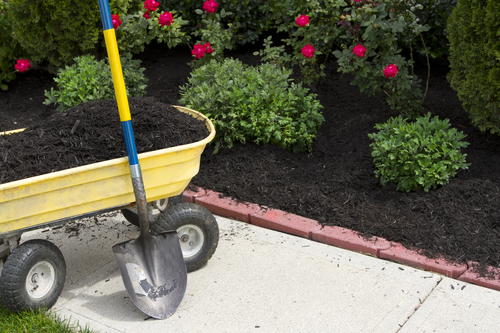
Basically there are two kinds of mulch that can be used in gardens and these are organic or inorganic mulch. Usually organic mulches consist of several different materials including chopped leaves, straw, grass clippings, wood chips, sawdust and shredded bark while inorganic mulches are mainly comprised of gravel, stones, black plastic, and geotextiles.
Nevertheless regardless of the type applied to a garden its use is mainly the same which is to discourage weed growth and improve soil quality however organic mulches gradually improve soil as they decompose while inorganic mulches don’t.
How To Mulch
Gardeners mulch gardens for a variety of reasons but depending on the reason there are certain tips that should be applied if this technique is to be done properly and is to work effectively.
Mulch To Be Rid Of Weeds
For instance if mulch is being used to eliminate weeds there are two important tips gardeners should remember if it is to be executed accurately. The first tip would be to place the it on soil that has already been weeded and the second would be to lay it down on soil thick enough to discourage new weeds from reappearing.
Normally the thickness of mulch should range from around 4 – 6 inches when applied however in areas where weed growth is not as common a layer of mulch measuring 2-3 inches should be enough to do the trick.
Mulching Reduces The Need To Water Gardens
As a great way to keep soil cool and help plants retain moisture in dry conditions gardeners can again apply mulch to their gardens. It also reduces the need to constantly water gardens and what’s more is that in cold conditions mulching also provides considerable protection to prevent the freezing and thawing of the soil as the gradual decomposition of materials only generate minimal heat.
Additional Tips To Consider
When using organic mulch it is important to remember that they carry a low nitrogen content therefore gardeners should first fertilize soil with a high-nitrogen product such as blood meal or fish meal to increase nitrogen levels in the soil before applying mulch.
Gardeners should also remember to keep mulch about an inch away from crowns and stems to prevent them from becoming choked or damaged and should also be careful not to allow wet mulch to rests against the stems of flowers and vegetables as it can cause them to rot.
So protect and maintain the ideal environment in gardens by considering mulching it will save you time and promote a healthy environment for your plants or vegetables.
Need Help In Your Garden?
If you don’t know what to do or need help mulching your garden don’t hesitate to give us a call at DK Landscaping Inc. at: (707) 217-6508 we’d be happy to come and give you a hand. You can also check out our website: dklandscaping.com to have a look at the services we offer.
How Mulch Can Be Applied To Your Garden v2
To keep gardens healthy and vibrant gardeners utilize mulching and it is one of the easiest and more commonly used methods in most gardens. Mulch is mostly available in two forms organic and inorganic and is mainly used to eliminate weed growth, lend additional support to plants and to help plants retain moisture. Mulch can be purchased from any gardening supply store or can even be formulated by gardeners themselves by recycling other products or materials.
Try Mulching!
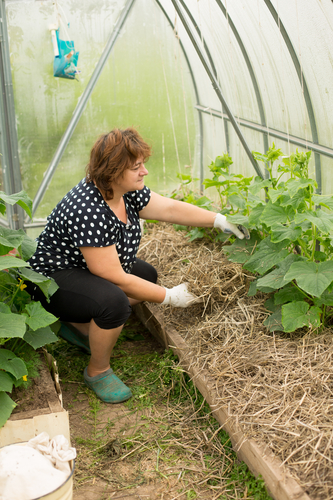
If you mow your lawn the clippings of grass that remain can be converted to mulch. Grass clippings have a high nitrogen content and can be used to naturally fertilize plants but works exceptionally well to fertilize vegetables.
For gardeners who have enough compost this too can be used as mulch. Once it isn’t dried out compost is great for enriching soil but to ensure that it provides the necessary nutrients and remains biologically active another layer of mulch such as chopped leaves should be added to cover the compost.
There are so many different things found in and around gardens that can be used to mulch. Having said using straw or hay throughout gardens is another excellent mulching option. It has most of the benefits of other mulches while adding organic matter to soil as it decomposes.
Gardeners should keep in mind when using hay or straw to make sure it is weed and seed free when making applications. They should also ensure that it is not placed too close to stems to prevent attracting slugs and rodents.
Did you know that mulching a vegetable garden with sheets of black plastic film can do wonders? This is another neat, gardening and mulching alternative that has proven to be very effective where the black plastic transmits the sun’s heat to the soil beneath, creating a microclimate that is about three degrees warmer than a garden that does not have mulch applied.
Since the plastic film remains warm and dry fruits and vegetables are protected, they don’t rot and they are kept clean. As with other mulches it prevents weed growth and retains moisture however when using plastic gardeners should remember to punch holes so that soil can still receive air and that plants and seeds can be transplanted or sown.
As we may know some mulches come in inorganic forms as well. Gravel, stones, and geotextiles can all be used to mulch gardens. Even though some are of a hard or rough texture and do not filter nutrients into soil they still allow air and water through to the soil beneath while keeping weeds from coming up.
These are all great ways to recycle materials or products in and around gardens or homes as well as to help gardeners to save money. Mulching is great for plants and vegetables and promotes a healthy environment throughout gardens so if you haven’t already maybe it’s time you start as you don’t even have to buy it you can make it and apply it yourself. Contact us for more information.
How Mulch Can Be Applied To Your Garden v1
One very useful and effective approach that gardeners can adopt to promote a healthy garden is mulching. This measure can be utilized in several areas including vegetable gardens and flower beds. The use of mulch can help to eliminate the presence of annoying weeds and helps soil to retain its moisture. Spend less time plucking up weeds, watering gardens and fighting pests when you use this technique.
Mulch For The Perfect Garden
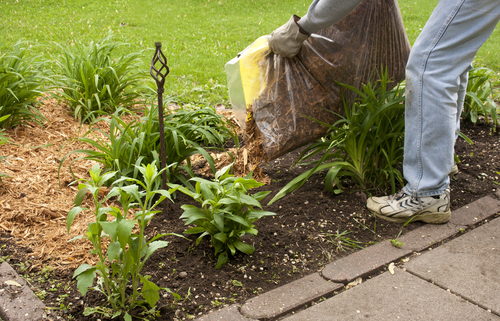
When mulching gardens there are two basic types of mulch that can be used and these are organic or inorganic. Organic mulches usually consist of several different,\ materials including chopped leaves, straw, grass clippings, wood chips,sawdust and shredded bark and inorganic mulches are mainly comprised of gravel, stones, black plastic, and geotextiles. Both types of mulch can be used to discourage weed growth and improve soil quality but organic mulches gradually improve soil as they decomposes while inorganic mulches don’t.
If people are applying mulch to combat weeds there are two important tips they should consider if it is to be done properly and effectively. The first would be to lay down mulch on soil that is already weeded and the second would be to lay it down thick enough to discourage new weeds from reappearing. The ideal thickness of mulch should range from around 4- 6 inches when laid even though a 2- 3 inch layer normally suffices in shady areas where weed growth is not as prevalent as it is in full sun.
Mulching is also an easy way to keep soil cool and moist in dry conditions and reduces the need to constantly water gardens. It provides protection to plants in harsh cold conditions preventing the freezing and thawing of the soil as the gradual decomposition of materials help to generate minimal heat.
Organic mulch has low nitrogen content and should fertilize soil first with a high-nitrogen product such as blood meal or fish meal to boost nitrogen levels in the soil before applying mulch. Another important thing that gardeners should take care to remember is to keep mulch about an inch away from crowns and stems. This is because wet mulch that rests against the stems of flowers and vegetables can cause them to rot. So be sure that mulch is at the appropriate distance to prevent this from occurring.
To protect and maintain the ideal conditions gardeners should definitely consider mulching as an option it is easy to apply, saves time and encourages a healthy, nurtured, environment throughout any garden. Contact us for more information.
Hardscape Ideas for Lawn Landscapes
In creating gorgeous landscape designs people tend to go above and beyond in seeking to create and achieve the look they want. There are a variety of techniques that can be used to not only enhance but to give an elegant finish to any landscape or outdoor space.
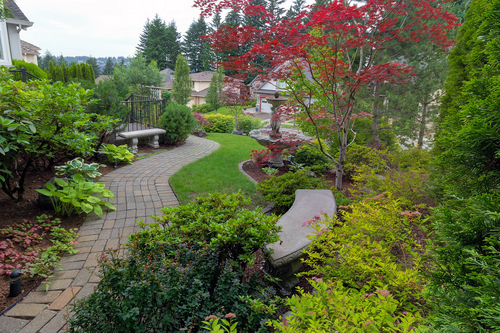
Bring Elegance To Your Landscape With These Hardscape Ideas
One very effective technique used to achieve the perfect finish to any landscape is Hardscaping. When speaking about hardscaping it refers to the structural inanimate features used and incorporated into a landscape to add a stylish and sophisticated appearance. These features can include anything from decks and walkways to edging and ornamental features and can be formal or informal depending on the style of your home and surroundings.
Nevertheless it is very important that varying textures be carefully considered as the texture of material/s used when hardscaping usually determines the final appearance of the landscape. Using too much or too little materials can result in a dull or cluttered finished look therefore to prevent any issues after the designed space is completed it would be best to choose no more than two or three textures of hardscape materials for projects.
Selected materials should be able to perfectly blend and complement the exterior structure of the home as well as be visually attractive. Other elements like color and drainage patterns once carefully and selectively used can and should improve the overall appearance of the home and surroundings.
Installing walkways and paths are also common elements incorporated within the hardscaping process and are used to accentuate and designate the areas in which traffic constantly travels. This is usually achieved by utilizing materials such as bricks, pavements, woodchips, flagstones, retaining walls, rocks or concrete blocks.
Different areas of the landscape may require various hardscape elements based on their purpose. For example using shredded tires painted in various colors for areas that children play or frequent. This provides a safe and attractive environment for kids who utilize outdoor surroundings for activities.
For areas used to entertain like dining or sitting areas the addition of a patio or deck accessorized with elegant furniture and decor are ideal ways to enhance and decorate big or empty areas. Water features like small ponds or fountains and ornamental accessories like a bird bath, statues or benches could also be great ideas that help to create a tranquil yet beautiful and characterized, outdoor space.
Once you have planned and designed the outdoor space that you wish to have the only thing left to do is to fill in your garden and lawn areas with the desired plants, trees or grass and proceed from there. Furthermore the addition of outdoor and garden lights will not only enhance and give ambiance to the outdoor area but provide a sense of safety and security when using outdoor spaces at night.
The concept of hardscaping really isn’t difficult to execute so long as planning is carefully and accurately done. It really gives an extra edge to outdoor spaces and surroundings while being an excellent expression of your unique taste and style. Contact us for more information.
Kinds and Uses of Fertilizer
Are you a gardening enthusiast or local farmer? Well if you are you most likely do all in your power to create and maintain a healthy environment for your blooms or crops. There are some cases though that crops or plants don’t grow to their full potential and one of the main reasons for this is poor soil quality. There are a few techniques that can be applied to rectify the issue of poor soil quality one of which is the use of fertilizer.

Fertilizers In Detail
Fertilizer can come in several forms and is an excellent way to enrich your soil and promote plant growth. Before using fertilizer with your plants or crops it would be a good idea to educate yourself on the different types of fertilizers and why they are used. It would also be best to read labels to ensure that applications are accurately made when using fertilizer. Here is a list of some of the most commonly used fertilizers in gardens or on farms. These include:
- Organic Fertilizer – These consist of naturally bio-degradable materials and mostly come in the form of animal manure but others can also contain compost, seaweed, peat moss, mineral deposits and other ingredients from nature. This type of fertilizer is great for gardens and crops as it not only restores the overall soil quality but improves the long term health of soil.
- Inorganic Fertilizer – Again this type of fertilizer can come in several forms including liquid, powdered or granular form. These fertilizers are generally used to treat industrial fields as they are cheaper and produced on a large scale. They also allow plants to carry nutrients from the soil easily since they are not as bulky as organic fertilizers.
- Chemical Nitrogenous Fertilizer – This type of fertilizer usually comes in granular form and has a high content of nitrogen. Once applied to the soil it is converted to ammonia and dissolves when it rains where the nutrients then travel through the ground and into the plant’s roots.
- Phosphate Fertilizer – This is mainly applied to soils that are acidic and is contained in both organic and synthetic forms. This type is usually applied during the sowing season.
- Potassium fertilizer – This is normally utilized to help improve plants thriving in sandy soil. It works to increase the potassium content where it’s inadequate. Potassium fertilizer can come in the form of sulfate of potash and muriate of potash. Sulfate of potash is made by treating potassium chloride with magnesium sulfate and muriate of potash uses a crystallized form of potash to fertilize plants which is absorbed at the surface level of the ground.
Now that persons are a bit more educated on the different types of fertilizers and their uses they should easily be able to determine how and what type of fertilizer they should use to achieve the best results with their plants or crops. Contact us for more information.
Ideas On How To Save Water For Gardening
Gardening is a recreational activity for many Californians. Creating and maintaining a lovely garden is the dream of every gardener. With seasonal plants, exotic varieties and breathtaking blooms nurturing and maintaining a garden can sometimes be pretty challenging task.
There are several activities and responsibilities that need to be considered and employed in order for a garden to be properly maintained and nurtured. One of these main responsibilities would most definitely include the provision of water to trees, plants and flowers.
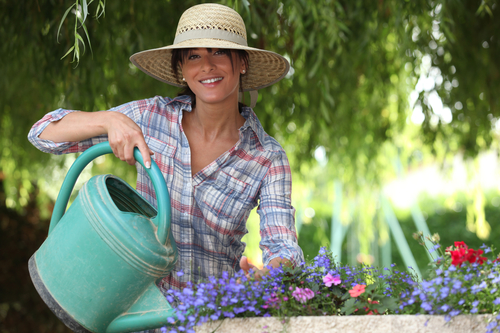
Successful Gardening
When it comes to supplying a garden with water most people have the perception that all is well so long as plants and flowers get watered however this may not exactly be true as there are many factors that can affect the way trees, plants and flowers receive water.
Since this is the case trees, plants and flowers can be affected in such a way that they don’t obtain sufficient nourishment to grow or bloom as they should. Even though this may be so giving trees, plants or flowers an excessive supply of water can be harmful to them and costly for you.
So in order to eliminate most of the issues that are encountered in gardens as it relates to watering plants incorrectly here are a few insightful tips that gardeners could utilize to reduce costs and water usage in gardens.
One very resourceful way to reduce the amount of water used in gardens is to attend and maintain soil. Adding mulch and organic matter to soil are both excellent ways to reduce the excessive use of water in gardens. They both help to improve water retention and soil structure so that plants don’t constantly need to be watered.
Disproportionately watering gardens tends to not only be a wasteful practice but also causes gardeners to do more work than is actually necessary. So to rectify this issue simply check to see if plants, trees or flowers do or do not require water.
To do this gardeners should take a spade and push it deep into the soil if it’s damp things are ok but if it’s dry then it’s definitely time to water. It is important to remember if you have clay soil it might feel damp whether it’s irrigated or not and sandy soil can feel dry even if it contains water. So in these cases gardeners should watch plants for when they start to show signs of water stress.
Knowing the best time to water plants is extremely important and by utilizing certain tools and techniques such as automated irrigation, sprinkler systems, watering cans or hoses water can not only be adequately supplied to plants at the required time but their use can minimize the amount of time spent and the amount of water used watering gardens.
In addition another way to supply water to plants and reduce usage would be to collect rain water. Place an empty receptacle at the end of drains to collect rain water whenever there is a shower of rain.
With this method people could reduce the usage of water in their gardens by 50% helping them to save money and at the same time still being able to care for their gardens.
These helpful tips can easily help gardeners to save time and money but most importantly it can help them to save a very, precious resource. Contact us for more information.





